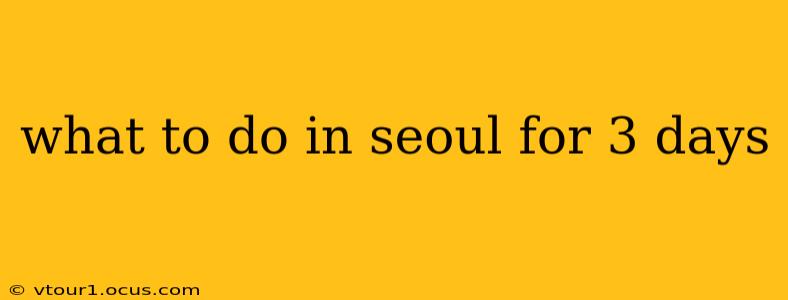What to Do in Seoul for 3 Days: A Whirlwind Tour of South Korea's Capital
Seoul, a vibrant metropolis brimming with ancient history and cutting-edge modernity, offers a captivating experience for visitors. Three days might seem short, but with careful planning, you can pack in a fantastic exploration of this amazing city. This itinerary balances iconic landmarks with off-the-beaten-path gems, ensuring a memorable Seoul adventure.
Day 1: Palaces, Panoramic Views, and Trendy Vibes
Start your Seoul journey by immersing yourself in history. Visit Gyeongbokgung Palace, the largest and most stunning of Seoul's five grand palaces. Witness the changing of the guard ceremony (check the schedule beforehand!) and explore the intricate architecture and serene gardens.
Afterwards, head to Bukchon Hanok Village, a charming neighborhood with traditional Korean houses. Wander through the narrow alleyways, admire the beautiful architecture, and perhaps even find a unique souvenir or enjoy a traditional tea ceremony.
For breathtaking panoramic views of the city, ascend N Seoul Tower on Namsan Mountain. Enjoy the stunning vista, especially beautiful at sunset. You can take a cable car or hike up – the choice is yours! The tower also boasts restaurants and shops.
Conclude your day by exploring the trendy Gangnam district, famous for its upscale boutiques, stylish cafes, and vibrant nightlife. Enjoy dinner at one of the many fantastic restaurants in the area.
Day 2: Culture, Shopping, and Delicious Food
Begin your second day with a visit to Insadong, a district known for its traditional crafts, tea houses, and art galleries. Browse through the numerous shops, pick up some unique souvenirs, and immerse yourself in Korean culture.
Next, indulge in some retail therapy at Myeongdong, a shopper's paradise offering everything from cosmetics and fashion to street food. This bustling district is a sensory feast, perfect for exploring and finding some unique treasures.
In the afternoon, explore the DMZ (Demilitarized Zone), a significant historical site offering a glimpse into the Korean War and the ongoing division of the Korean peninsula. A guided tour is highly recommended for a comprehensive and informative experience. (Note: This requires pre-booking and allocating a significant portion of the day.) Alternatively, you could explore a different aspect of Korean culture, like visiting the National Museum of Korea.
End your day with a delicious Korean BBQ dinner – a must-do experience in Seoul!
Day 3: Temples, Parks, and Farewell Delights
Start your final day with a visit to Jogyesa Temple, a significant Buddhist temple in the heart of Seoul. Experience the serene atmosphere and admire the beautiful architecture.
Spend some time relaxing in Olympic Park, a sprawling green space perfect for a leisurely stroll or a picnic. This park is a great place to unwind and soak up the city atmosphere before your departure.
Before heading to the airport, make sure to grab some last-minute souvenirs or enjoy a final delicious Korean meal. Consider visiting a traditional Korean bathhouse (jjimjilbang) for a unique and relaxing experience.
Frequently Asked Questions (FAQs)
H2: What is the best time to visit Seoul?
The best time to visit Seoul is during spring (April-May) and autumn (September-October) when the weather is pleasant and the crowds are manageable. Summer can be hot and humid, while winter is cold and can experience snowfall.
H2: How much does a trip to Seoul cost?
The cost of a trip to Seoul varies greatly depending on your travel style and preferences. Budget travelers can get by on around $50-$75 per day, while luxury travelers may spend significantly more. Accommodation, food, and transportation costs should be considered when budgeting.
H2: What is the best way to get around Seoul?
Seoul has an excellent public transportation system, including a comprehensive subway network and a large bus network. The T-money card is highly recommended for easy and efficient travel. Taxis are also readily available.
H2: What are some must-try Korean foods in Seoul?
Seoul offers a plethora of delicious Korean dishes. Must-tries include Korean BBQ, Bibimbap (mixed rice with meat and vegetables), Kimchi jjigae (kimchi stew), and Korean fried chicken.
H2: Is it easy to navigate Seoul without speaking Korean?
While knowing some basic Korean phrases is helpful, it's generally easy to navigate Seoul without speaking Korean. Many signs are in English, and most people in tourist areas speak at least some English. Translation apps can also be very useful.
This itinerary provides a framework; feel free to adjust it based on your interests and preferences. Remember to check opening times and book tickets in advance for popular attractions, especially during peak season. Enjoy your unforgettable Seoul adventure!
